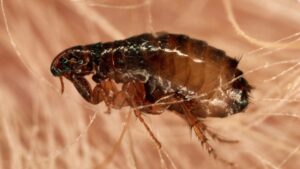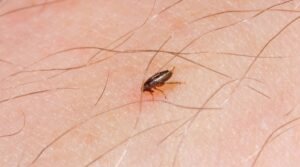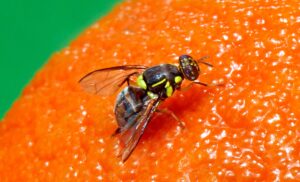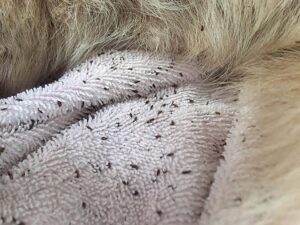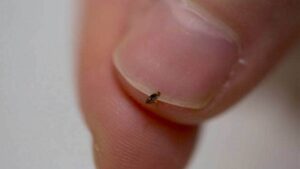If you’ve ever noticed itchy red welts on your ankles or other parts of your body or your pet, you may have suspected a flea bite. And you’re probably right in thinking so.
Because these tiny, irritating insects feed on blood, they bite both humans and animals. As a result, when they invade your home or infest your pet, they may be a real hassle.
Fleas have also proven to be a thorn in the flesh, as they are evasive and appear to be difficult to destroy. How so? They move swiftly and make effective use of their tiny body mass. Therefore, you must first understand how they move to deal with them.
So, how much do you know about fleas? Is it true that fleas have wings? What is the movement of a flea like? What other insects have similar features?
This article provides answers to all of your flea-related inquiries and help you understand how to get rid of a flea infestation with relevant flea facts.
Can Fleas Fly?
The short answer is no. Thankfully, fleas can’t fly. What fleas do is leap high off the ground and attach themselves to moving objects.
However, given how high fleas jump, it’s logical to imagine that they fly. After all, they have powerful hind legs that can propel them to an altitude of 150 times their own.
Their leaping abilities are so astounding that some engineers have sought to replicate them using miniature leaping robots. In addition, their entire leap range is roughly 8 inches.
This is why flea eradication in your house is so crucial. A minor infestation (even tiny flea larvae) can swiftly spread with fleas’ propensity to jump.
Do Fleas Have Wings?
Fleas and flea eggs belong to the Siphonaptera insect order; they don’t have wings. Aptera, the suffix of their order, literally means “without wings” in Greek.
So, whether it’s cat fleas or dog fleas, they can’t fly. If you’ve ever looked at a flea up close, you’ll notice that it resembles a hybrid between an insect and a lobster. To illustrate, when examined under a microscope, the flea’s body doesn’t resemble that of a bug!
Unfortunately, identifying fleas isn’t as simple as you may assume. Several flea-like insects are frequently confused for fleas.
How Does a Flea Move?
How can a flea go around with no wings? Fleas, like most insects, use their legs. They use their tiny, muscular legs to jump when they need to move farther.
Fleas, oddly, hop backward every time they jump. So, while they can leap up to eight inches, they may decide to sit nice and comfy in the fur of their host.
How Do Fleas Feed?
Fleas are generally inclined to bite warm-blooded mammals, although they can also feed on cold-blooded species like birds and reptiles.
To illustrate, they’re parasitic insects that live on the bodies of their hosts. Humans, however, aren’t furry enough to make effective flea hosts. Fleas can bite people, and they do, but they won’t stay in their body hair for very long.
Otherwise, they’ll happily spend the rest of their lives on pets. Domesticated animals, such as cats, dogs, rabbits, small rodents, and other animals, are particularly susceptible to flea infestations. They infect both domestic and wild animals.
Furthermore, when fleas infest a home, they can survive for days or even weeks without feeding in carpets or blankets. But, of course, they can’t exist without a host indefinitely; fleas eat to survive.
As a result, if you find fleas in your home, it’s more probable that they’re just leaping around looking for their next blood meal.
In addition, fleas enjoy a moderate temperature and don’t thrive in extreme hot or cold conditions. Unfortunately, this is why these insects prefer to live among humans and pets. They’re at ease in the same settings as we are, and they flourish in our air-conditioned living quarters.
What Looks Like a Flea But Can Fly?
If you see creatures that look like fleas but fly, you can be confident they aren’t fleas.
They can, however, be fruit flies, which are arguably the most prevalent types of tiny flying insects we find around our houses. They’re attracted to the odor of rotting fruits and vegetables and don’t bite. Other flea-like insects we can find in the house include springtails and tobacco flea beetles.
Springtails are generally bigger than fleas. They prefer to live in the open rather than indoors. Springtails don’t bite because they don’t enjoy feeding on human blood.
Tobacco flea beetles exhibit unique behavior in that they rarely choose a pet’s body as their host. As for flea, beetles leap like fleas because their rear legs are broad and robust, making them excellent jumpers.
There’s also the sand flea to consider. Sand fleas, often known as chiggers, can be found in tropical countries. They have wingless bodies and dig in the sand, just like ordinary fleas.
Sand fleas prefer to bite barefoot people and burrow deep into the softer flesh of the feet. As a result, severe inflammation, ulceration, and allergic reactions occur to the victims.
Identifying Fleas and Flea Infestation
Every flea has a head, thorax, abdomen, and six legs, just like most other insects. And these insects are tiny and flat, which allows them to travel readily through an animal’s hairs. Nevertheless, the same trait makes them difficult to hold on to if caught between your fingers.
Adult fleas are relatively easy to spot on an animal host. Separate a pet’s fur, dog, or cat, and examine its skin with your fingertips. If fleas are present, their little, black bodies should be visible amongst the hairs.
Nevertheless, fleas like the dark and will try to hide when exposed to light, so even if you see one, it’ll most likely hide shortly.
Moreover, flea bites are very common evidence of a flea problem. Human flea bites appear as red, itchy patches or welts.
flea bites induce itching; they can also trigger an allergic reaction on human skin and a pet’s fur.
Flea-infested animals may develop bald spots with exposed skin that’s red, rough, flaky, scaly, and irritable. If your notice your pet scratching excessively, they’ve likely been bitten by fleas.
Now that you’ve identified fleas on your dog or pet expect that there are more fleas around. However, you can check for a flea infestation in your house with a few simple tests.
Wear white socks, and take a walk around your house, keeping an eye out for little black spots on your feet and ankles. When walking in locations where fleas could hide, such as carpeted areas, tread carefully. This way, you can effectively cover the ground.
Alternatively, here’s a basic flea trap that you can also put up: Fill a bowl halfway with water and a few drops of dish soap, and place it down with a light shining on it.
If there are fleas around, the warmth flowing from the light will draw them. The dish soap will drown them underwater when the fleas fall into the water.
What Kills Fleas Instantly?
Because fleas multiply and spread quickly, the best approach for pet owners to keep their pets and home free of fleas and flea eggs is never to let them get that far. In other words, keeping your home flea-free is more manageable than clearing a flea infestation.
The solution is simple; get a prescription from your veterinarian for an efficient flea control treatment (like a flea comb) and regularly use it on your pet.
If your pet already has a flea problem, you should consult your veterinarian to identify the best treatment. Following that, take additional steps to eliminate fleas and destroy flea eggs in your home.
What you should do is to keep your living quarters tidy, eliminate clutter, and vacuum thoroughly to get rid of fleas and flea eggs on your pets or in your home.
Also, clean your bedding regularly, especially if you have pets who sleep in your bed. Clean your pet’s bed regularly as well. After all, cleaning flea-infested clothes or pet bedding doesn’t require any special preparations; a routine pass through the washing machine with soap should do.
Finally, if you’re thinking of giving your dog a flea bath, you’ll be disappointed to learn that it may not work effectively. Because fleas have developed a tolerance to most over-the-counter (pet store) medications, they are no longer effective in combating infestations.
Bottom Line
Although fleas are unable to fly, they do hop a lot. And boy, do they enjoy doing it.
Fleas may appear to be a minor annoyance, but they can cause severe irritation to you and your pets. You can protect your animals from flea infestations by understanding how fleas behave and what signs to look for.
Ultimately, the best way to defend your pet from these leaping parasites is to find flea prevention methods for your pets and carefully clean your home and yard.
Hopefully, now that you know what signs to look for and procedures to take, you’ll be able to maintain a flea-free pet and home!
References:
https://www.thebugsquad.com/fleas/do-fleas-fly/
https://www.petcamp.com/cat-fleas-how-they-get-them-how-to-ditch-them/
https://kapturepest.com/fleas-fly/
https://www.orkin.com/pests/fleas/can-fleas-fly
https://insectcop.net/bugs-like-fleas/
https://agrilifeextension.tamu.edu/library/insects/controlling-fleas/


